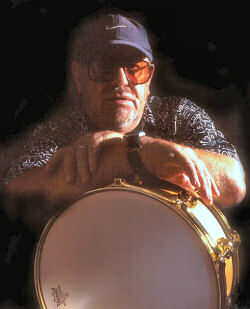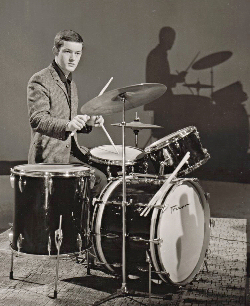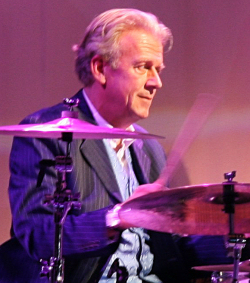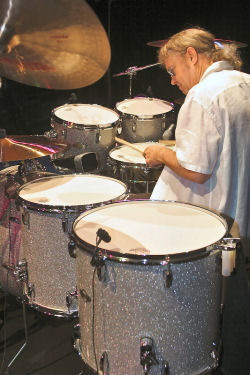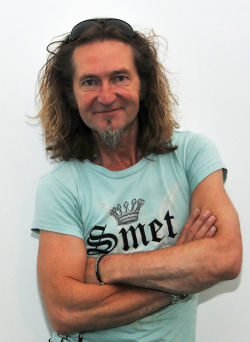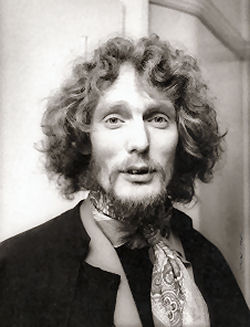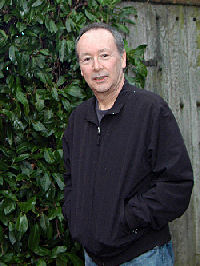
Brian Downey, London, March 2007
There’s little doubt that Thin Lizzy had an enormous impact on the world during the 1970’s and 1980’s and few rock aficionados could have failed to have been impressed with the drumming therein courtesy of Dublin drum legend, Brian Downey.
The day after storms tore across England in January, I picked my way through debris and fallen trees to SARM Studios to meet Brian who was on the last day of recording Gary Moore’s new album. Due to the destructive weather 24 hours earlier, the studio complex was without power so Brian and I settled down to talk through his career whilst the emergency generator was delivered and hooked up.
ME: Who got you started on the drums?
BD: The person who got me playing initially was my Dad, but he didn’t really have much of knowledge of swing music or jazz even though he was very interested in jazz. But there was one or two albums hanging around the house that no one listened to that made me very curious. My Dad was a postman and he happened to bring these albums home as they had never been picked up, they were from America, and someone said take them home and have a listen.
One of them was an album called ‘Back Door Blues’ by a guy called Eddie ‘Cleanhead’ Vincent, so I played it and this stuff was totally alien to me! This had Louis Hayes on drums and he playing stuff that sounded really intricate, but very fresh as well. I persevered and tried to play along to these records, another one was an Oscar Brown Jnr record and there was a song on it called ‘When I Was Cool’, a real sort of blues shuffle thing which was very influential. So I was listening to this stuff around 11 or 12 years of age, but not really taking it too seriously
I had started playing when I was about 9, I was in a pipe band in Dublin and there were always drums in the house because my Dad was designated every once a month to clean the drums. So there were always a couple of big drums around, perfect for me to bash away on, even though the neighbours were not too pleased! So I was playing away to these records on the pipe drums and had a practise pad as well, but my cousin who lived with us brought these ‘Shadows’ records home and they really grabbed my attention. I thought the drummer, Tony Meehan was quite good and when he played a solo on ‘The Shadows’ record; ‘See You In My Drums’ that became an influence as well.
I would practise every day religiously just to get some semblance of beats…
I was playing along to these tracks and then The Beatles exploded and everything changed then, I mean everything! That’s when I started to think about buying a set of drums and pestered my Dad to go down to the local furniture shop to get a kit. In those days Cavendish’s in Grafton Street, a big department store selling furniture also sold drums, guitars and all the rest of it. It was ideal because my Dad used to buy all our furniture in that shop! So I just pestered him one Christmas time and when he asked “What do you want for Christmas?” I said I wanted a kit of drums! He said I couldn’t have a drum kit as it was too expensive so I made a list of what I wanted; snare drum, tom-tom, floor tom, a couple of cymbals, but I ended up only getting the bass drum, snare and the hi hat. It was a little kit of Olympic Drums, no spurs on the bass drum, I don’t know how I played it without the spurs, I used jam something under the drum to stop it wobbling.
I would practise every day religiously just to get some semblance of beats, I didn’t really know how to coordinate between my foot and my left hand and my right hand, it took me a while to get used to that. I glad in the end that I didn’t have a ride cymbal, which is what I really wanted, because it gave me a sort of independence between my right foot and my left hand.
I didn’t have too much to hit so I used to concentrate on getting some sort of a beat going and it gave me some sort of independence. Even though I wasn’t playing any sort of independent pattern on the hi hat by any means, at that stage I was just going through the motions just to get the sounds. But there again, I was listening to the Shadows and then the Beatles came out and then I was listening the Stones, the Kinks and all these ‘British Invasion’ bands.
There was a couple of guys on our street who decided to buy a few guitars and form a band and one guy who was only five minutes away said to me “You play drums, I’ve heard you playing in your bedroom, it sounds quite good why don’t you join our band?” I said “OK, what kind of music is it?” It was all the regular hits which was OK I suppose. I was about 13 at this stage and everybody else was a little bit older, around 15, 16, 17 so I was kind of young but I joined his band and we used to practise in his front room. Then they got a bass player in, that was really good because then I got another dimension of how to play, it was a real eye opener listening to bass and drums.
I thought Ringo invented the backbeat…
ME: When you listen to the early Rock and Roll songs from the 50’s, you can hear the drummer playing a swing beat whereas say, the piano is playing straight 8’s on top of it because the ‘back beat’ hadn’t happened until people like Ringo came along.
BD: Oh yeah, Ringo really had that backbeat, very few people were playing the straight two and four on the snare until Ringo came along. Obviously there American drummers playing this but I was never aware of them, I thought Ringo invented the backbeat, because everyone else was playing; (plays ‘knee’ snare on 2-e & 4) so that was a bit of an eye opener and all this sort of thing was influencing me, I was taking it all in. So I got into this band, we got gigs in the local school hall, we’d get a couple of Mars Bars at the end! And that’s how it all really started.
ME: Can you remember the kits you’ve used over the years?
BD: I had the Olympic red sparkle for about 4 or 5 years, but I had to sell it to get a proper Premier kit with a tom tom. So I had a proper kit then, two cymbals, snare, bass drum, rack tom, floor tom and that was the making of my full kit. I kept it for a good few years and eventually ended up getting a set of Haymans. I started of with Lizzy using the Premier kit for the first couple of rehearsals and gigs. By the third or fourth gig I had the Haymans which was really nice. I was looking for two bass drums but it was a little bit expensive to buy a kit with two bass drums.
Then there was a kit of Gretsch with a pair of big 26” bass drums, we recorded ‘Fighting’ with the Gretsch and ‘Nightlife’ as well, so there’s two albums with the Gretsch on it. Around the third album, that’s when I was considering getting another kit and I got rid of them and got the Rogers kit.
When I got that kit, it was a mixture of white, black and different colours because I couldn’t get a kit of proper chrome drums in London for love nor money. So I went to Chas. Footes and asked him to do a job on it, he said: “Look, it might take a couple of weeks,” so I hired a kit off him while he was doing the Rogers. When I went to pick them up with one of the road crew, everything was lovely until I got to the bass drums and it looked like they were bubbled, the wrap didn’t stick to the shell properly and I wasn’t too pleased with that. But the tour was starting in a couple of days I just had to take them and use them, but I eventually took them back and he sorted them out. I think he was rushing to get them ready and put them too close to a radiator.
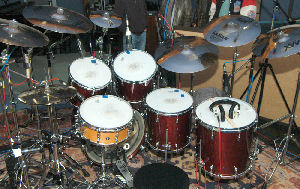
Brians Yamaha Maple Custom Absolute kit
Tama came to me and at the time everyone seemed to be getting endorsements, Phil had an endorsement with Ibanez and Scott had Yamaha and Tama turned up and said ‘How about trying our kits?’ But I kept hankering back to the Rogers kit and even after 6 months of playing Tama, I thought maybe I should get the old Rogers back out, but there again, in the back of my mind I knew that this (Tama) was a decent endorsement. Then they phoned me up one day and said; “Look, Billy Cobham has designed these new drums called Superstar drums, do you want to try a kit?” So I said ‘Yeah, send them down and I’ll have a go’.
ME: So, you’ve still got the Rogers then?
BD: I still have the Rogers, well my son has it, I said ‘Take care of it’, whether he has or not, I don’t know. I’ve still got some of the concert toms in the attic, I never used them with Lizzy, but I still have them so he has the double bass drums, the 12”, 13”, 14”, 16”, so they’re still knocking around, I still have the Tama kits, two of them are still in existence and I still have the Hayman kit. The only regret I have is selling the Gretsch, I had to get rid of it to buy the Rogers.
ME: What’s the weapon of choice these days?
BD: Yamaha Absolutes with a maple snare. I got a good deal on them.
ME: Can you recall what cymbals you used?
BD: I remember staring off using Zyns, then I went on to Super Zyn, then Paiste at one stage and I eventually ended up using Zildjian cymbals, everybody was using Zildjian at the time. A guy came to a few of the gigs to see if I wanted a Paiste endorsement, but I was using Zildjian at the time and I didn’t want to change.
ME: Lizzy had a very fresh. Clean sound that I think is still relevant today, it’s interesting that in the early 80’s, you didn’t fall into the trap of following fashion of the New Wave of Heavy Metal.
BD: No we didn’t, Lizzy was always that kind of a band where we never said “Let’s become a metal band,” we were influenced by Deep Purple and Hendrix but Phil had this real quiet side to him. Sometimes he’d say; “Let’s do something totally different, you play with brushes,” and it was like “Yeah, brilliant, let’s do that!” Something just to totally change the atmosphere, Phil was great at that, it was an interesting bond we had to say the least. Even though the hard rock and metal fraternity like Lizzy, we got comments like; “Some of your albums are little too soft for my taste, but I like ‘that’ album and I like ‘this’ album because they’re heavy!”
Phil wanted it (‘Whisky In The Jar’) to be a ‘B’ side…
ME: On a couple of Lizzy tracks, there’s a lot of Irish influence, was that deliberate from the band’s background and growing up?
BD:” Whisky In The Jar” was a track we always messed about with, because it’s an old song. ”Whisky” was one of the songs that was played at this time and Phil suggested we try it one day at a rehearsal. Our manager came into a rehearsal and said it sounded brilliant, so he arranged for the next time we were in Decca’s studios to put it down to see how it sounds. Phil wanted it to be a ‘B’ side and we use ‘Black Boys In The Corner’ as the ‘A’ side, so we did that and when Decca heard both tracks they said ”Whisky” should be the ‘A’ side. Phil wasn’t pleased, but he was persuaded as it was a commercial proposition and when it was released it took ages to get into the charts. Even in Ireland, it took a while to chart but it did eventually get to Number 1.
”Whisky In The Jar” was a song that started our fans asking for more folk based vibe and it got to the stage where we’d turn up at gigs where people were expecting a whole set of traditional songs. We were playing Phil’s own material and the audiences were walking out! But it started us on the road, if we didn’t get a hit at that time, I think we would have struggled on but financially we were really staring to feel the pinch. We spent more time in Ireland doing tours to make money to see us over in England for six months, any money we made in Ireland, we’d live on here.
ME: Are there any modern drummers you take influence from?
BD: Loads. Brian Blade is a great drummer, I went to see him recently and he’s just fantastic. But there’s so many young drummers coming up nowadays its hard to keep track of them.
ME: Can you tell me anything about the current project you’re involved in here?
BD: The current project is the new Gary Moore album and a British tour around May so the album should released around the same time. I’ll be doing the tour, dates in the UK and some dates in Russia, Turkey, and Scandinavia.
Brian will be touring with Gary Moore in the UK through May and June 2007; 24 May – Norwich UEA, 25 May – Folkestone Leas Cliff Hall, 27 May – Glasgow Academy, 28 May – Newcastle City Hall, 30 May – Wolverhampton Civic Hall, 31 May – Liverpool Philharmonic Hall, 2 June – Manchester Apollo, 3 June – Bristol Colston Hall, 5 June – Portsmouth Guildhall, 6 June – Oxford New Theatre, 8 June – London Shepherds Bush Empire and 9 June – Brighton Dome,
Mike Ellis
March 2007

